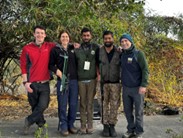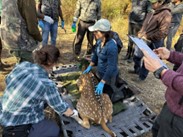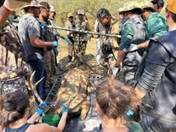
20th February
by Dr Mariana Costa Cruz Santos & Dr N.Kalaivanan
We can barely acknowledge that it is Tuesday, with how busy and diverse the past 10 days have been. And we definitely do not want to acknowledge that we are over the half-way mark.
The early morning chai folks adopted a novel strategy today. To the usual knocking, our kind hosts added a vocal call. Despite this, and regardless of the cumulative tiredness or short sleep, the chai and the breakfast add a little hop to the rise from bed.
The day’s subject was the Human-Wildlife-Livestock interface, starting with an introductory lecture by Dr. Neil Anderson. We explored the definition of interface, with temporal and spatial proximity between species being the two main factors associated with it.
These areas of interface are of great benefit for humans, but also areas where disease transmission might occur, depending on environmental, host and agent factors. A percentage was shared with us, 80%, for the amount of domestic pathogens that can infect wildlife. Nonetheless, an interesting study was shared to demonstrate that not all is concerning – in interface areas of increasing human activity the species richness did not vary, only the composition.
The concluding remarks from this session reminded us of how the different elements in an ecosystem are interconnected, and hinted at how we were about to visit a location displaying a prime example of human-wildlife interaction.
All aboard the bus, with the much needed hats and face scarves – against sun and dust, respectively – we drove into the heart of Sariska Tiger Reserve. Our aim was to visit the Pandupole temple. After paying our respects in the temple and having some chai and katchori, we split into five groups and headed into the waterfall.
The beautiful landscape was doing its best at keeping us from our assignment, which was identifying hazards as part of a disease risk analysis. During our journey, we witnessed people feeding macaques, touching and sitting down with a troop of langurs, sharing the same water sources and driving off while these were still on the roof of their vehicle.
Some people climbed up the dry waterfall, and we are unsure if they conducted a proper risk assessment before!
Once done with our explorations and assessments, we drove back to Sariska. Our trip was full of fascinating sightings, with cute Chital, several Sambar, noble Nilgai, meandering Mongoose, and plenty of Peafowl. The environment around us was characterised by date palms and a few canyons, but we will let the pictures show you how they looked.
On our return, a long lunch allowed us some moments of relaxation and further discussion on the group assignment. We then sat down under the great ficus tree, tutored by Lee and Neil, and shared our group conclusions, exploring hazards such as rabies, nutritional issues, leptospirosis and tuberculosis. The discussions were fruitful and helped us understand the thought-process that might go into a DRA, leaving everyone more comfortable with applying these into their own workplaces.
As the sun was setting and shining its golden light onto us, a few large clouds approached, thundering, and rain started pouring for the first time during this course! As fast as it came, with the smell of dust, it went, allowing the amazing Amber and great Gowri to share with us some presentations – from hyenas’ diets to a gharials’ mass mortality incident!
Another day, another generous dinner.
Another night, this one unique with its rain, lulling us further into a well-deserved rest.



